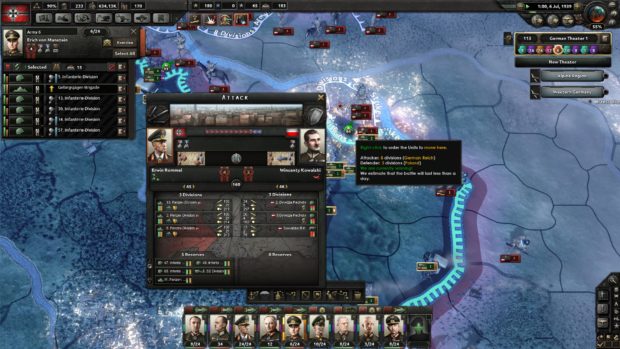Detailed grand strategy games on World War II are few and far between. Most present either a high level of abstraction or switch to an operational or tactical scale to present more detail (while sacrificing the bigger picture). The Hearts of Iron series aspires to more, however, attempting to convey leadership of a nation in a huge war, while still allowing the player the freedom to command at a divisional scale in combat. Hearts of Iron 3 (especially following its final expansion), in its pursuit of this goal, presented a game that was hugely detailed but also incredibly complicated, almost to the point where the game became unplayable. Hearts of Iron 4, on the other hand, while still embracing a significant level of details, also balancing this with an excellent interface and a number of features that make running a global war not only more possible, but more fun.
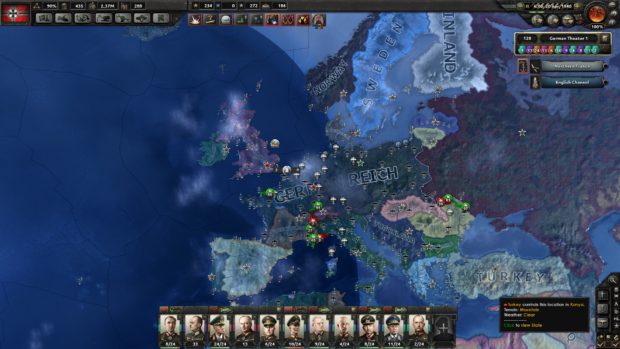
Hearts of Iron 4 has two scenarios- a 1936 start where, unless you’re Italy or Ethiopia, you start the game at peace, and a 1939 start where the world is on the brink of total war. In classic Paradox fashion, you can pick any nation in the world to play as, so, while there are only two scenarios, there are a huge number of ways to play. Still, I did find myself pining for a 1942 or 1944 start to get into the late war in a more historical way. Without that option, I had to earn my way to the conflict. The game does an excellent job of making any nation playable- while the great powers do have more well developed national focus trees, the generic focus trees for the other countries are very powerful, allowing for you to take your country in any direction you wish.
Running a nation on the brink of all-encompassing conflict is, as you probably can guess, an arduous task. Paradox, however, has included an excellent tutorial, which allows you to play a guided opening as Italy in the 1936 scenario. It’s informative, showing the basics on managing production, factories, trade and so forth, and teaches you how to fight in the war against Ethiopia. As the tutorial ends, you have the option to continue with an Italian playthrough, giving you the ability to put all you learned to the test. I, however, jumped straight into a 1936 playthrough as my Hearts of Iron 3 standby- Germany.
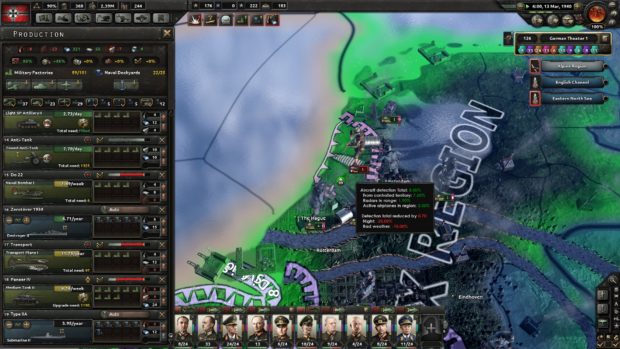
I’d always found the 1936 start in Hearts of Iron 3 to be overly intimidating. Building the German war machine was not an obvious thing- learning the ins and out of economy and production was tough. In Hearts of Iron 4, everything is much more obvious. A well-designed interface and alerts pointed me at the points that needed attention. If I had civilian factories (used for building more factories, fortifications, infrastructure, trade and a number of other functions) being unused, I knew. If military factories (used for producing items of military use) out of work, it was obvious. The production interface makes where to direct you attention obvious, telling you which light tank you need to produce and which support weapon you already have enough of. You can switch your factories to build whatever you want at any time, but changing to a completely different item of production requires retooling of the factory and results in a temporary penalty to production. Research is a simple matter of picking the next item in the research tree- with variants available for purchase based on battle experience. All of that is the long way of saying Hearts of Iron 4 takes a very complicated operation, production, much easier to run and much less intimidating that it is in similar games.
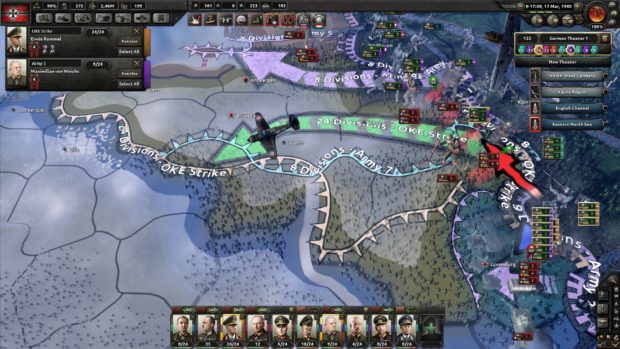
The most controversial part of Hearts of Iron 4 to be sure is the removal of the command echelon of the previous game and replacing it with a much more manageable system in which you can group units into armies and give these armies orders. The echelon system, while historically accurate, was always obtuse, and difficult to manage. As fun as it was for the spreadsheet warrior type, the new system is much better from a playability standpoint. Units can be groups in armies. Armies can be assigned to garrison areas, or to defend sections of the front line with a few simple clicks. Want to plan an offensive? Simply choose your army, draw the path of advance on the map, and when the time is right, hit the execute button. It’s a great system, one that takes one of my favorite ideas from the previous game (the ability to draw battle plans on the map) and makes it a core game function. Being able to plan naval invasions, to assign units to particular axes of advance- it’s heady stuff. As much as the grognards may malign the lack of historicity, this system simply plays better, and really makes the game functional as a multiplayer game. It makes it easy at a glance to know what all your troops are doing, and armies without orders are flagged so they stick out, meaning it’s easy to reassign them to new missions.

Graphically, Hearts of Iron 4 is a huge improvement over its predecessor. My invasion of France, which in the previous game was a bunch of NATO-style counters following arrows, now became a sight to see. French and British fighters battled my BF-109s in dogfights high above the tanks and infantry marching through the Ardennes. Off the course, my submarines sank convoys while fleets sailed in patrol off the Danish coast. The game is something to watch, and given that a playthrough takes many hours, the graphic efforts are greatly appreciated.
Speaking of the naval portion, I did find this a bit more difficult to manage than the land portion. Assigning fleets to missions and getting them into position seemed very finicky. I did really enjoy the naval combat- the end of battle reports gave a good sense of what had happened (especially the one that showed me British carriers at the bottom of the North Sea). I wish there was something similar for land campaigns to give them more weight and a sense of accomplishment (or, well, failure I suppose). The aerial campaign, dividing the world into zones, seemed to work well- it was easy to give orders to all the aircraft assigned to a particular zone, and the game prompts you to any unassigned aircraft.
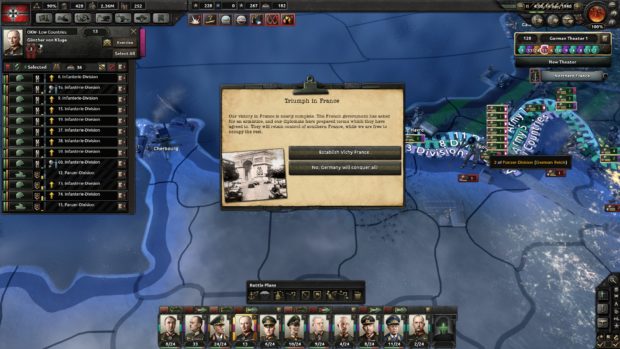
Hearts of Iron 4 is probably not the game series veterans were looking for. It makes a lot of concessions to playability over historicity that its predecessors did not. Yet those decisions do not remove the player from his position as head of a World War II nation. As the head of Germany (okay, fine… as Hitler), I managed my economy, I directed my nation’s diplomatic efforts (staging a coup in Roumania, signed alliances and advanced the Axis powers), and I conducted military campaigns in broad strokes. The scale feels right, and the game plays so well. I’ve always wanted a World War II game where grand strategy was the focus, where the details mattered, and that I could play without dedicated my entire life to a single game. Hearts of Iron 4: World War II is a grand strategy you can actually play.
